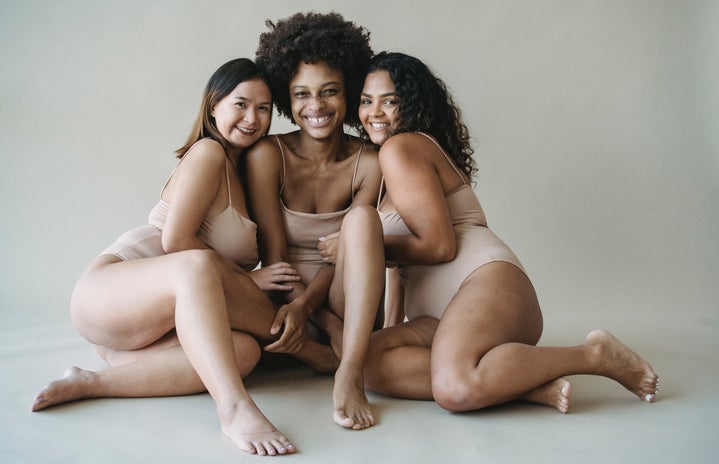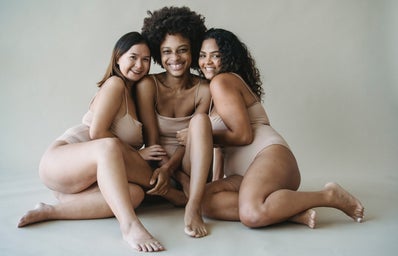Today, we live in a world where beauty is defined by the way women look and dress. With the rapidly ever-changing beauty standards of our modern world, it often becomes overwhelming and degrading to attempt to keep up with. As our world evolves and beauty standards continue to change its definition of what is considered “beautiful”, a woman’s body (a place where they should feel completely comfortable) can turn against her in an attempt to maintain the apparent social norms. The common saying ‘beauty is in the eye of the beholder’ eliminate standards of beauty that exists on their own, but are created by individuals through representations on social media and advertisements. I find it so important to try and ignore the beauty standards and to be whoever you want to be – but this can be a daunting task. Being this vulnerable can be a terrifying experience, and potentially leads to feeling self-conscious and unappreciated.
So, next time you feel like your own body might be less than perfect, just remember that “perfection” is a temporary ideal, bound to change and transform from one generation to the next.
- The Victorian Era
-
The Victorian era, the era of the corset.
In this time period, women cinched their waists with tight-fitting undergarments to give the perception of the desirable hourglass figure. This accessory was vital to a Victorian woman and her position in society, regarded as a “loose woman” if refusing to wear it. However, to achieve their teeny tiny waists women were paying the ultimate price. Making their corsets tighter and tighter, the long term affects damaged the position of women’s organs, shifting them up and down, affecting other organs positions within the body as well.
Along with damaging themselves internally, to achieve a upper-class look, women would delve into a range of dangerous tactics to uphold these unrealistic beauty standards, a few included:
– Putting poison into their eyes to make them doe-like
– Using soot as mascara
– Rubbing road tar on their eyebrows to shape them
– Lead as concealer
– Arsenic in many beauty products
So even though our beauty standards today are no picnic, it may come as a relief that we won’t be seeing literal poisons on skincare by Hyram any time soon.
- The 1920s
-
While in decades past they squeezed themselves into form-fitting corsets and other undergarments, fads and trends, the Roaring Twenties were a time of more casual clothing and young immature women with carefree attitudes. Female shoppers no longer accentuated their curves – they hid them. The hourglass figure was out; boyish slimness was in, with “beautiful women” expected to have short hair and a small chest. Women of the 1920s were also expected to frequently diet and exercise in order to stay extra slim.
- The 1930s and 40s
-
Just a decade later, suddenly being too skinny was out and curves were back in with women often expected to be curvy and emphasise their feminine features to avoid a “skinny look”. Women were expected to have a natural waistline with clothing tending towards practicality subserving to the war time spirit.
- The 1950s
-
As men returned from battle reclaiming their jobs, women left their work-clothes behind and felt the need (fashion dictated) to be feminine again. The ideal 1950s women remained full-figured with a voluptuous, hourglass look. Hollywood became increasingly more popular creating new fashion icons, like Marilyn Monroe, and expanding the options for this decade. Women were expected to leave home looking flawless with perfect skin and makeup. This time period put a lot of pressure on women to look their best at all times to stay sexually attractive as women were told that their main goals should be to catch a man and have a family.
- The 1960s
-
The 1960s were a drastic change from the 1950s. Women’s bodies were now expected to be “twiggy” and lack curves and shape. Twiggy was a famous model in the 1960s and pushed women to be as skinny as they could be. These women had a minimal chest, small hips and a boyish figure. The ideal was super skinny and girly or ultra-feminine and curvy. As you can see, these ideals are unrealistic for many women to achieve for a variety of different reasons for example individual’s bone structure and medical conditions.
- The 1970s
-
After the cinched waists of the 50s and the super-slim models of the 60s forever changed the way women viewed their bodies, by the 1970s, the thinking-thin phenomenon was in full force. Women were encouraged to lose all their extra body fat and to lose the curves and large chest. Some women became dangerously thin in order to fit into the modern society. Blown-out waves and natural makeup, demonstrated a mixture of the hippie ideals of beauty and the early disco trends. The bronzed skin, glossy lips, and layered, feathered haircut, revolutionized women’s beauty and became the look that every woman wanted to have.
- The 1980s
-
The 1980s created the rise of the “hard body” and the thin build. Supermodels became very popular and created an unrealistic picture for women. The media pushed for women to be slender and placed an emphasis on height. The aerobics obsession of the 80s continued to emphasize fitness for women, and the female body was expected to maintain a certain weight, but still appear toned, all without being too muscular. Although the ideal size was fuller than the 90s and the early 2000s, all these body restrictions still caused eating disorders to skyrocket throughout the decade. Between cropped football player shirts and shiny spandex leggings (that was just a few of the typical trends that was considered sexy), the body was very much on display. At this point in history, being sexy was an acceptable and expected thing for most young people.
- The 1990s
-
Throughout the 1990s women were pushed to be slim, yet have larger chests in order to fulfil Pamela Anderson’s Baywatch look. American women faced an impossible beauty standard, they were expected to be bony and have unhealthy BMIs. On one side there was the glamazon super model, such as Elle Macpherson, Cindy Crawford and Naomi Campbell, with their athletic, but curvaceous figures. On the other side there was Kate Moss who marked the beginning of the ‘waif’ look (A physical presence of youth and extreme thinness; a fashion style featuring this look), and started a revolution not only in modelling but also consumer fashion.
The pressures of having perfect boobs, slender long legs and a flat tummy with abs was huge and did not take long before plastic surgery and dieting trends eventually started to blossom and the pressure kept rising all the way into the new millennia.
- The Contemporary Ideal
-
Today, body image is still something that women struggle with. We are pressured to be the perfect looking, well-dressed, flawless females of society. But why are looks so important? Past ages and their flaws have laid the groundwork for today’s body ideal and trend interpretation. The distinction between equalisation and objectification had never been so blurred, and it was the first true realisation of the dangers of a distorted body picture. Television shows, movies and music videos seem more like soft porn, and stage outfits that looked more like lingerie shroud an ideal of cool, sweet or wholesome role-models. Many turn to silicon, fake tan, and hair extensions to acquire a curvy figure whilst maintaining rock-hard, flat abs.
With the growing obsession with social media, influencers are taking to their platforms to promote apparent routines and diets in order to look how they are perceived. When speaking to my friends about writing this article, we all spoke of the toxic atmosphere on tik tok with trends such as ‘what I eat in a day (x calorie edition)’. These videos usually include, a full-length body picture of the creator, followed by calorie deficits, intermittent fasting and “meals” that look more like snacks, with viewers left feeling insecure about their eating habits.
Through increasing activity on social media, modern advertisement utilises young impressionable minds to sell their products, targeting age groups most likely to want to achieve an idealistic standard of beauty. The first example that came to my mind was the Victoria Secret fashion show and their marketing.
The ad above shows a row of scantily-clad glamazons accompanied by the label “The Perfect Body”, although this slogan was later changed to ‘A body for everybody’ after the Internet rightly lost its shit over the original. There is no such thing as a perfect body; arguing this is risky and can have significant consequences for female’s self-esteem around the world. The idea that new knickers will assist in achieving ‘perfection’ is much riskier. After all, there’s an art to making money out of insecurity, and the underwear industry, in particular, has it refined.
Even though today we are still pressured to be perfect, society has come a long way. It makes me wonder whether we are entering a new age of body positivity and acceptance where beauty standards are no longer important. Many companies, like Dove, are promoting body positivity movements and letting women know that every single body is beautiful. Even mainstream artists and influencers such as Lizzo are using their platforms to spread a worldwide message of love and positivity surrounding the subject. Happiness and self-confidence are key and can help women strive for their goals. The beauty standards have changed, evolved, and even improved, but we still have a long way to go. So, be your best self and don’t let anyone else’s standards define who you are.



